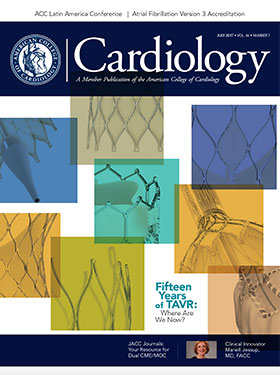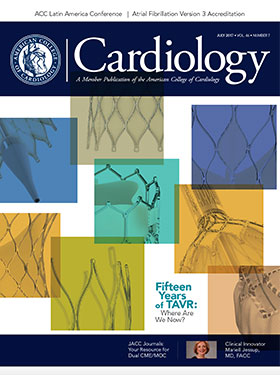Noninvasive Assessment of CAD with FFRCT: The New Gold Standard?
The ideal test for evaluating coronary artery disease (CAD) should incorporate both anatomic and physiologic data regarding coronary artery stenosis. Traditionally, ischemia has been evaluated with stress testing followed by invasive coronary angiography (ICA) or by invasive angiography with fractional flow reserve (FFR) assessment using a coronary pressure wire.
The PROMISE trial reported similar outcomes using either coronary computed tomography angiography (CTA) or stress testing for assessing the severity of coronary artery stenosis, but the specificity of CTA was low.1 The emergence of FFRCT, in which FFR is calculated from CTA data, has provided a noninvasive test that yields both anatomic and functional data. Several recent studies have evaluated the effectiveness of FFRCT for assessing coronary lesion severity.
The PROMISE trial investigators assessed whether FFRCT added to CTA was a better predictor of coronary revascularization and outcomes than CTA alone in patients with stable chest pain referred to ICA after CTA.2 This retrospective sub-study included 181 patients who underwent CTA, ICA and FFRCT. They found that patients with an FFRCT ≤0.80 were significantly more likely to have coronary revascularization and to meet the composite endpoint of major adverse cardiac events (MACE) or revascularization than those with FFRCT >0.80. An FFRCT ≤0.80 was a significantly better predictor of the composite endpoint compared with severe CTA stenosis (hazard ratio, 4.31 vs. 2.90; p = 0.033). The study also showed that reserving ICA for patients with FFRCT ≤0.80 could reduce the rate of performing ICA after CTA by 28 percent, decrease the rate of ICA without ≥50 percent stenosis by 44 percent and increase the rate of ICA leading to revascularization by 24 percent.
The emergence of FFRCT, in which FFR is calculated from CTA data, has provided a noninvasive test that yields both anatomic and functional data.
FFRCT was compared with CTA alone for assessment of lesion severity and patient management in 200 patients with stable chest pain in the FFRCT RIPCORD study.3 The patients underwent CTA and FFRCT was calculated. Three interventional cardiologists assessed the CTA data for each patient and developed a management plan by consensus. The four management options were: optimal medical therapy (OMT) alone; PCI plus OMT; CABG plus OMT; or more information about ischemia required. The FFRCT data were then revealed and the cardiologists again decided on a management plan by consensus. They also recorded the FFRCT results for each vessel that was considered ischemic. The endpoint was the difference between management plans based on the CTA alone or FFRCT data. After assessing the FFRCT data, the cardiologists changed the management plan for 72 patients (36 percent) based on assessment of lesion severity. Including changes in the PCI target vessel, treatment decisions were changed in 44 percent of patients.
In the PLATFORM study, 584 patients were allocated to noninvasive or invasive coronary angiography cohorts.4 Each cohort was divided into standard of care and FFRCT guided care groups. The 90-day primary endpoint of invasive catheterization without obstructive CAD occurred in significantly fewer patients with FFRCT-guided care vs. usual care in both cohorts. Of the 584 patients, 581 completed one-year follow-up. The one-year endpoints were MACE, total medical costs and quality of life (QOL). At one year, two MACE occurred in each arm of the planned invasive cohort and one occurred in the usual care group of the planned noninvasive cohort. No events occurred in the 117 patients whose planned ICA was cancelled due to CT/FFRCT results. Median costs were lower with FFRCT vs. usual care (p < 0.01) in the invasive cohort and similar in the noninvasive cohort (p = 0.82). QOL scores improved at one year, with similar improvements in both care groups.
Coenen and colleagues investigated the individual and combined accuracy of FFRCT and dynamic CT myocardial perfusion imaging (CT MPI) in 74 patients in whom ICA and invasive FFR were planned.5 A total of 142 vessels were studied. The sensitivity and specificity of CTA were 78 percent and 49 percent respectively. The sensitivity, specificity and diagnostic accuracy were 73 percent (95 percent CI, 61-86 percent), 68 percent (95 percent CI, 56-80 percent) and 70 percent (95 percent CI, 62-79 percent) for CT MPI and 82 percent (95 percent CI, 72-92 percent), 60 percent (95 percent CI, 48-72 percent) and 70 percent (63-80 percent) for FFRCT. The diagnostic accuracy for CT MPI integrated with FFRCT was 79 percent (95 percent CI, 71-87 percent). The diagnostic accuracy was 77 percent for a simulated stepwise work-up of FFRCT with selective use of CT MPI. CT MPI and FFRCT demonstrated comparable accuracy in identifying functionally significant CAD. Diagnostic accuracy was improved with a combination of both methods.
A real-world study of the clinical utility of FFRCT for decision making in patients with stable CAD was conducted in all patients with new-onset chest pain referred for CTA over 12 months.6 Based on the CTA results, the patients were referred to ICA (n = 82), FFRCT (n = 189) or MPI (n = 44). Conclusive FFRCT results were obtained in 185 patients. FFRCT was ≤0.80 in 57 patients and >0.80 in 128 patients. ICA was performed in 53 of these patients, with FFR (19 percent) or instantaneous wave-free ratio (iFR) (1 percent). FFRCT ≤0.80 accurately classified 73 percent of patients and 70 percent of vessels using an FFR ≤0.80 or iFR ≤0.90. No cardiac events were reported among patients with FFRCT >0.80 who were deferred from ICA during a median follow-up period of 12 months.
A prospective study by Gaur and colleagues assessed the performance of FFRCT for the diagnosis of lesion-specific ischemia in nonculprit vessels of 60 patients with recent STEMI and multivessel CAD.7 Coronary CTA was performed one month after STEMI. FFRCT was calculated and lesion-specific ischemia was defined as FFRCT ≤0.80. The patients underwent ICA one day after CTA and FFR was performed in 168 vessels, including 124 nonculprit vessels. FFRCT compared with CTA alone improved accuracy (72 vs. 64 percent; p = 0.033), specificity (66 vs. 49 percent; p < 0.001) and positive predictive value (56 vs. 48 percent; p = 0.032). There was no difference between FFRCT and ICA estimates. There was moderate agreement between FFRCT and FFR. The median volume-to-mass ratio was lower than in patients with stable angina, which influenced the diagnostic performance of FFRCT. Because of the moderate diagnostic performance of FFRCT, the investigators concluded that the routine use of FFRCT in post-STEMI patients is not supported.
"The demonstrated clinical applicability of invasive FFR determined over 20 years of research cannot simply be transplanted to its noninvasive counterpart. That privilege must be earned." — Justin E. Davies, MBBS, BSc, PhD, and Christopher M. Cook, MD
In an editorial comment on the FFRCT PROMISE trial, Subha V. Raman, MD, MSEE, FACC, and Karolina M. Zareba, MD, state that the distribution of pretest likelihood of CAD in the PROMISE cohort facilitates translation of the results to daily practice – if FFRCT results are available, they should be used for revascularization decision making.8 In an editorial comment on the RIPCORD trial, William F. Fearon, MD, FACC, and Jang Hoon Lee, MD, agree that the addition of FFRCT significantly improves the diagnostic accuracy of CTA compared with invasively measured FFR.9 They pointed out the effect that FFRCT has had on decision making even when used routinely in a consecutive group of patients, noting that if the technique was only used in cases with abnormal CTA, even more dramatic differences in the treatment plan would be expected.
The success of FFRCT studies has led to the widespread expectation that it will enter the mainstream soon, state Justin E. Davies, MBBS, BSc, PhD, and Christopher M. Cook, MD, in an editorial.10 “However, enthusiasm for FFRCT must be tempered by an appreciation of some of the limitations intrinsic to the technique,” they added.
Among the limitations described by these and other reviewers are the need for thicker slice collimation in obese patients, the high cost of the proprietary FFRCT software and the need for faster turnaround of results. In addition, algorithmic improvements are needed to make FFRCT available to a broader patient population. Davies and Cook note the major limitation of FFRCT is that “uniform and constant values of microvascular resistance and coronary flow do not exist.” The failure of the study using FFRCT to diagnose lesion-specific ischemia in nonculprit vessels to demonstrate high diagnostic accuracy of FFRCT in recent STEMI patients was likely due to the substantially lower total coronary vessel lumen volume relative to left ventricular volume to mass ratio compared with patients with stable angina. James K. Min, MD, FACC, Y. S. Chandrashekhar, MD, FACC, and Jagat Narula, MD, PhD, MACC, speculated that the presence of severe coronary calcification and blooming artifacts from partial volume effects may have confounded FFRCT accuracy in the recent STEMI population.11
Importantly, FFRCT has not been evaluated in a direct comparison with invasive FFR in a prospective patient outcomes study. “The demonstrated clinical applicability of invasive FFR determined over 20 years of research cannot simply be transplanted to its noninvasive counterpart. That privilege must be earned,” write Davies and Cook.
References
- Douglas PS, Hoffman U, Patel MR, et al. N Engl J Med 2015;372:1291-300.
- Lu MT, Ferencik M, Roberts RS, et al. JACC Cardiovasc Imaging 2017;April 7:[Epub ahead of print].
- Curzen NP, Nolan J, Zaman AG, et al. JACC Cardiovasc Imaging 2016;9:1188-94.
- Douglas PS, De Bruyne B, Pontone G, et al. J AM Coll Cardiol 2016;68:434-45.
- Coenen A, Rossi A, Lubbers, et al. JACC Cardiovasc Imaging 2017;10:760-70.
- Norgaard BL, Hjort J, Gaur S, et al. JACC Cardiovasc Imaging 2017;10:541-50.
- Gaur S, Taylor CA, Jensen JM, et al. JACC Cardiovasc Imaging 2017;10:424-33.
- Raman SV, Zareba K. JACC Cardiovasc Imaging 2017;10:April 7:[Epub ahead of print].
- Fearon WF, Lee JH. JACC Cardiovasc Imaging 2016:9:1195-97.
- Davies JE, Cook CM. JACC Cardiovasc Imaging 2017;10:434-6.
- Min JK, Chandrashekhar Y, Narula J. JACC Cardiovasc Imaging 2017;10:500-2.
 |
|
| Click the cover image above to read the latest issue of Cardiology in e-pub format or click here to read it on the web! | |
Keywords: ACC Publications, Cardiology Magazine, Coronary Angiography, Myocardial Perfusion Imaging, Coronary Artery Disease, Angina, Stable, Prospective Studies, omega-Chloroacetophenone, Retrospective Studies, Constriction, Pathologic, Myocardial Infarction, Coronary Stenosis, Catheterization
< Back to Listings

